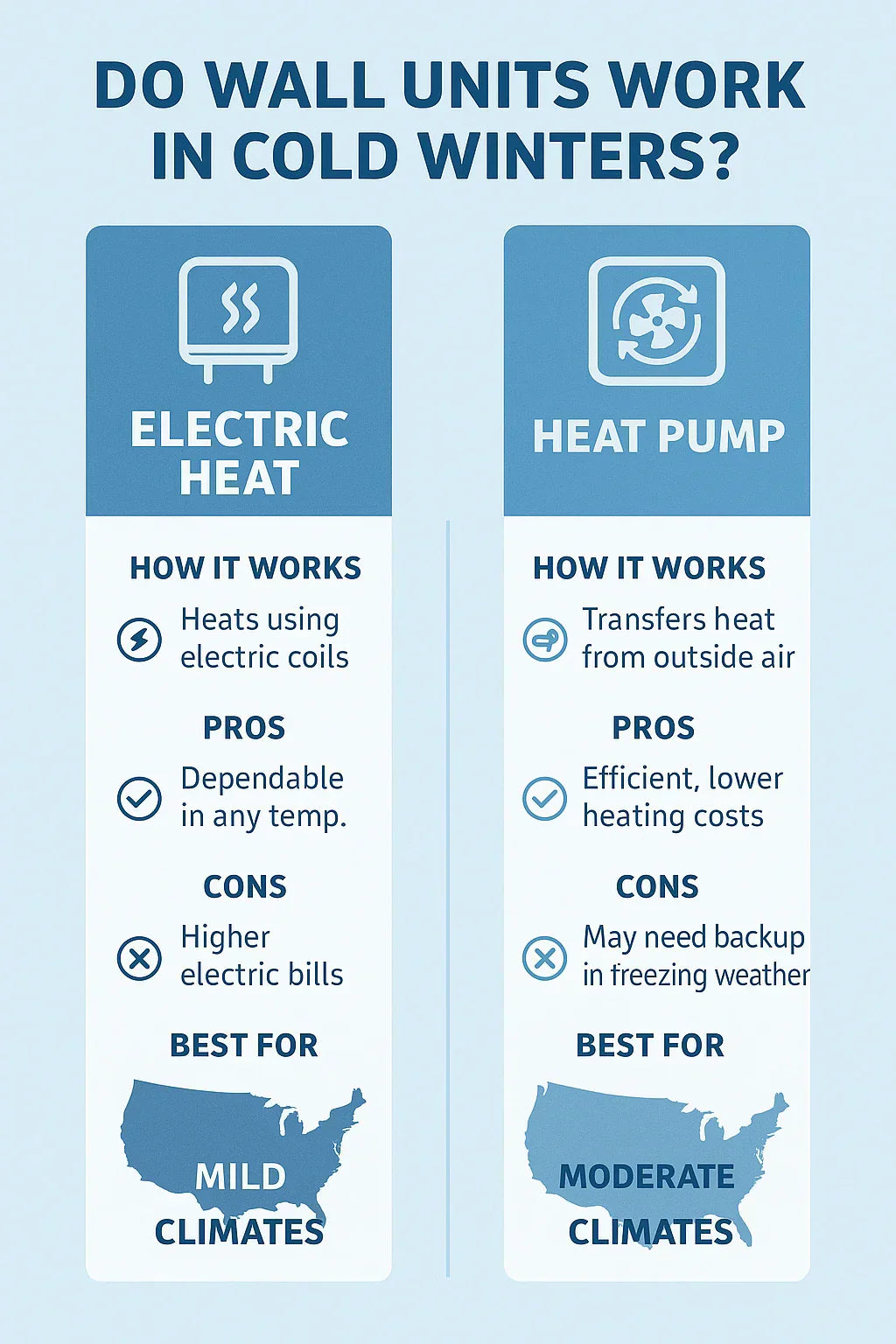Most people think of wall units—whether from Amana, GE, or Hotpoint—as a way to cool a room in the summer. But here’s the surprise: many models are designed to provide year-round comfort. That means heating in the winter, not just cooling in the summer.
But the big question remains: Will these units really keep you warm when the temperature drops?
The answer depends on the type of heating technology inside your unit: either electric resistance heat kits or heat pump systems. Each works differently, and each comes with trade-offs depending on your climate, budget, and comfort expectations.
Let’s break down exactly how these heating options compare.
🔥 How Electric Heating Works in Wall Units
Most basic wall units—especially budget models from Hotpoint—use electric resistance heating.
-
How it works:
-
Electricity runs through a heating element (like the coils in a space heater).
-
A fan pushes air over the element, sending warm air into the room.
-
-
Pros:
-
Simple and reliable—no moving parts beyond the fan.
-
Heat is instant; no lag time.
-
Works regardless of outdoor temperature.
-
-
Cons:
-
Expensive to run in cold climates.
-
Uses more electricity than a heat pump for the same heat output.
-
Less efficient for long heating seasons.
-
👉 According to the U.S. Department of Energy, electric resistance heat can cost 2–3 times more to operate than a heat pump in many regions.
💡 Best For: Homes in mild climates (like the South) or as a backup option in very cold regions.
🌡️ How Heat Pump Wall Units Work
Heat pump technology is more advanced—and more efficient.
-
How it works:
-
Instead of generating heat, it moves heat.
-
In winter, it pulls heat from outside air and brings it indoors.
-
In summer, it reverses to work like an air conditioner.
-
-
Pros:
-
Far more efficient—uses up to 50% less electricity than electric resistance heat.
-
Provides both heating and cooling in one system.
-
Eligible for rebates and tax credits if EnergyStar certified.
-
-
Cons:
-
Performance drops in very cold temperatures (below ~30°F).
-
May need supplemental electric heat in freezing climates.
-
Slightly higher upfront cost.
-
👉 See EnergyStar’s guidance on heat pumps for climate performance details.
💡 Best For: Areas with mild to moderate winters, or as the main system in southern states.
🔴 Amana Heating Options
-
Offers both electric resistance and heat pump wall units.
-
Known for durable builds and strong warranties.
-
Heat kits available for many models, providing supplemental heat.
👉 Browse Amana PTAC units to compare heating options.
💡 Verdict: Reliable heating in any climate, but best paired with supplemental systems in extreme cold.
🔵 GE Heating Options
-
The GE Zoneline series is famous in hotels and condos.
-
Offers efficient heat pump models with backup electric resistance.
-
Some models include smart sensors to reduce energy waste.
👉 See GE Zoneline PTAC for model specs.
💡 Verdict: A great choice if you want efficiency plus tech features—especially in climates where winters are cold but not extreme.
⚪ Hotpoint Heating Options
-
Focuses primarily on budget-friendly electric heat models.
-
Few or no heat pump offerings.
-
Lower upfront cost, but higher operating costs in winter..
💡 Verdict: Best if you just need a simple, affordable solution and don’t plan to rely on it as your primary winter heating source.
🧮 Real-World Cost Comparison
Let’s compare annual heating costs for a 12,000 BTU wall unit in a climate with 4 months of winter use:
| Heating Type | Annual Cost (avg.) | Notes |
|---|---|---|
| Electric Heat Kit | $450–$600 | Higher bills in long winters |
| Heat Pump | $200–$350 | Much more efficient |
| Hybrid (Heat Pump + Electric Backup) | $250–$400 | Best balance in mixed climates |
👉 Based on national average electricity cost of $0.13/kWh
💡 Takeaway: A heat pump unit may cost $200–$300 less per year than electric-only heating.
❄️ Cold Climate Performance
In Mild Winters (South, Pacific Coast)
-
Heat pumps shine—efficient and cost-effective.
-
Electric kits work too but will cost more.
In Moderate Winters (Mid-Atlantic, Midwest)
-
Heat pumps work well but may need occasional backup.
-
Best bet: a unit with both heat pump + electric kit.
In Harsh Winters (New England, Northern Plains)
-
Electric resistance is more reliable but costly.
-
Many homeowners use wall units as supplemental heat alongside furnaces or boilers.
📊 Brand Heating Comparison
| Brand | Electric Heat Kits | Heat Pump Models | Cold Climate Performance | Cost Efficiency |
|---|---|---|---|---|
| Amana | ✅ Yes | ✅ Yes | Reliable w/ backup | Moderate |
| GE | ✅ Yes | ✅ Yes | Excellent w/ hybrid models | High |
| Hotpoint | ✅ Yes | ❌ Limited | Weak in harsh winters | Low |
📝 Samantha’s Final Thoughts
When I first looked at wall units, I assumed heating was just a bonus. But after digging deeper, I realized the heating type you choose can double or triple your winter energy bills.
Here’s my take:
-
If you live in a mild or moderate climate, a heat pump wall unit is your best bet.
-
If you live in a harsh winter climate, choose a unit with both heat pump + electric backup—or use the wall unit as supplemental heat.
-
If you’re on a tight budget, Hotpoint electric models work, but expect higher bills.
So, do wall units work in cold winters? Yes—but only if you choose the right type for your climate.
In the next topic we will know more about: Amana vs. GE vs. Hotpoint: Which Brand Is Best for Your Home?







